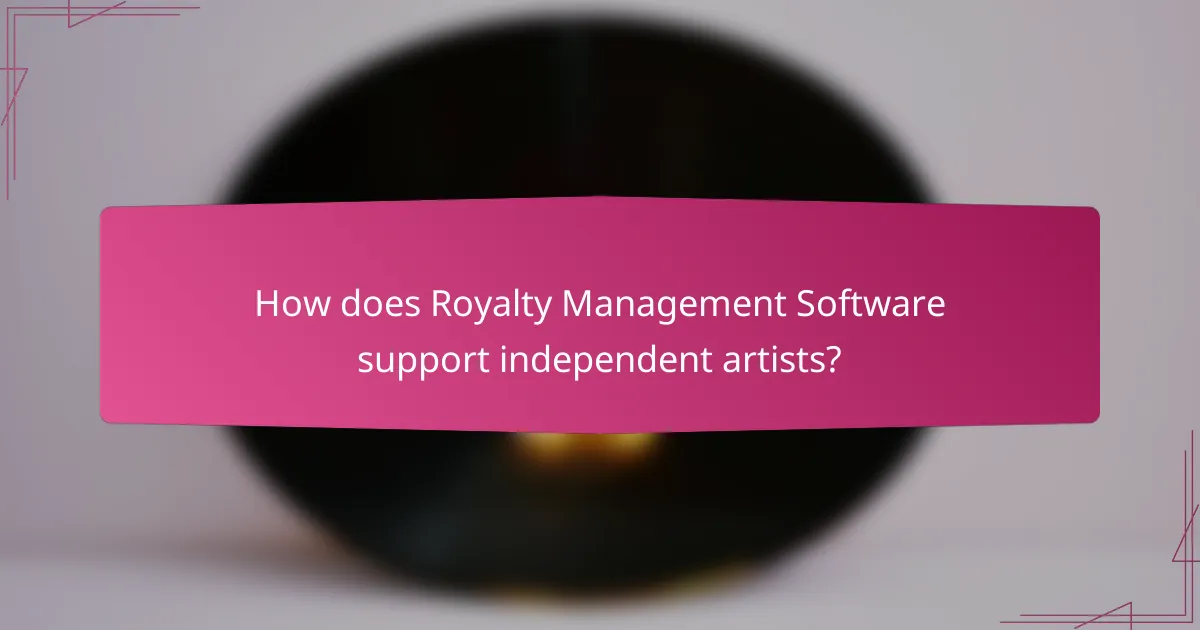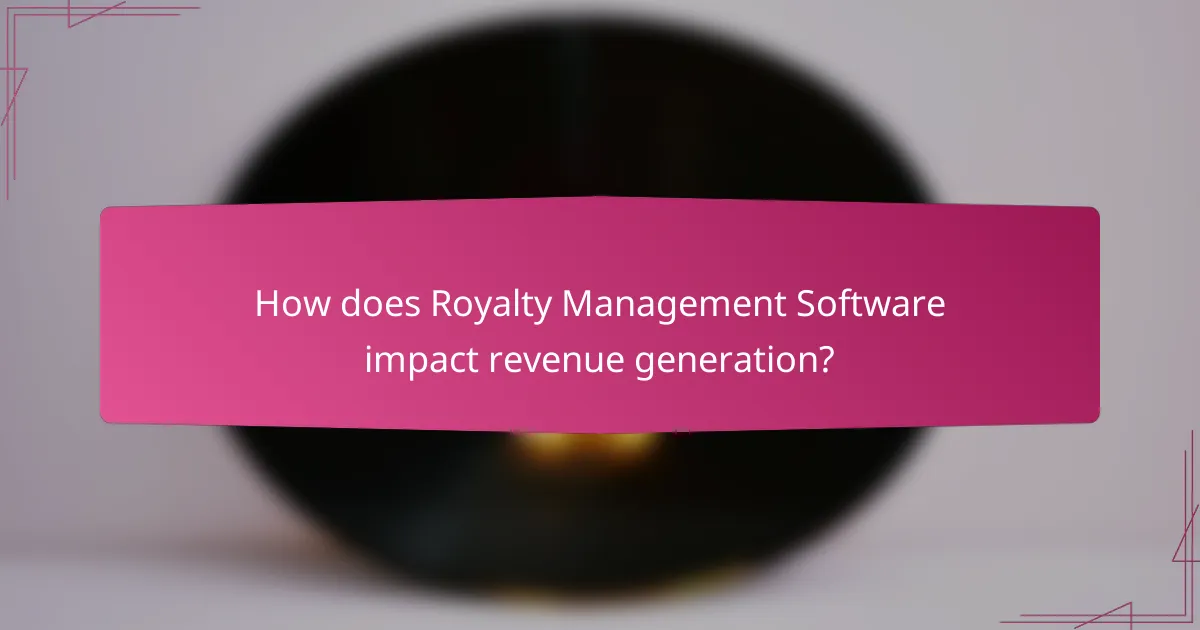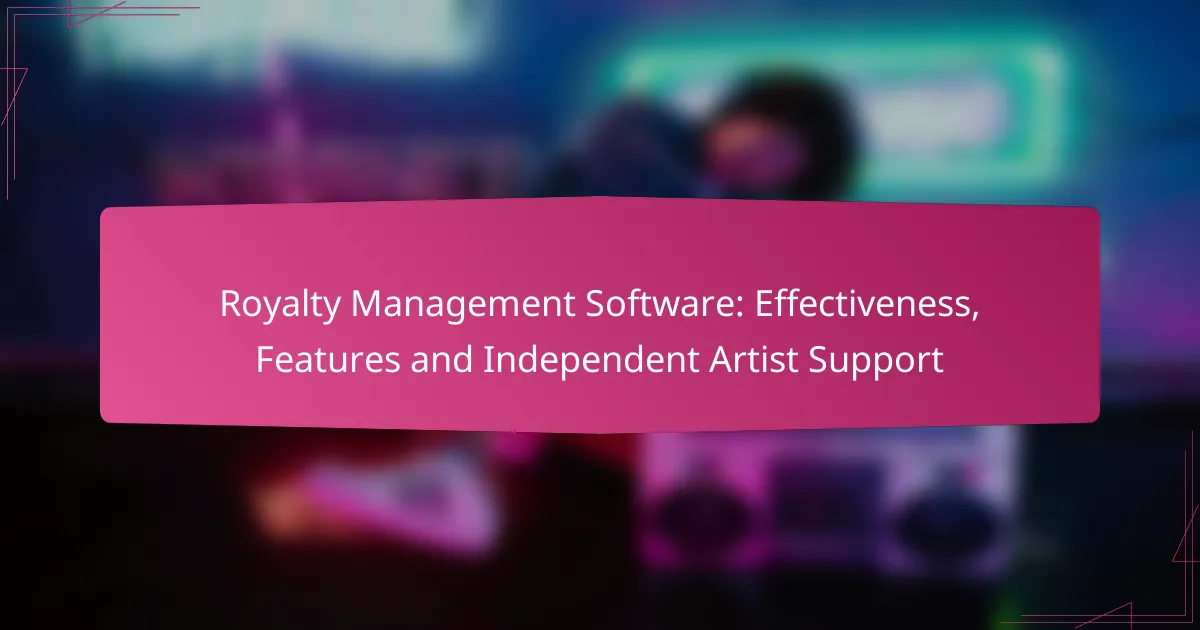Royalty management software is essential for independent artists, providing them with the tools needed to efficiently manage earnings and track royalties. By automating processes and enhancing transparency, these solutions allow artists to concentrate on their creativity while ensuring they receive fair compensation for their work.

How does Royalty Management Software support independent artists?
Royalty management software provides independent artists with essential tools to efficiently manage their earnings and track royalties. By automating processes and offering transparency, these solutions empower artists to focus on their creative work while ensuring they receive fair compensation for their contributions.
Streamlined royalty tracking
Royalty management software simplifies the tracking of various income streams, such as streaming royalties, licensing fees, and merchandise sales. Artists can easily monitor their earnings in real-time, allowing them to understand which revenue sources are most profitable. This streamlined approach reduces the administrative burden and minimizes the risk of errors in calculations.
Many platforms offer dashboards that visualize earnings over time, making it easier for artists to spot trends and adjust their strategies accordingly. For example, an artist may notice that their streaming revenue peaks during certain months, prompting them to plan promotional activities around those times.
Enhanced revenue transparency
Transparency in revenue reporting is crucial for independent artists, and royalty management software provides detailed insights into how earnings are generated. Artists can access breakdowns of their income, including specific amounts from different platforms and sales channels. This level of detail helps artists identify discrepancies and ensures they are compensated fairly.
Additionally, some software solutions allow artists to share reports with collaborators or managers, fostering trust and accountability. This transparency can lead to better negotiations with labels or distributors, as artists can present clear data on their earnings and performance.
Automated reporting features
Automated reporting features in royalty management software save artists time and effort by generating regular financial reports without manual input. These reports can include monthly earnings summaries, tax documents, and performance analytics, which are essential for financial planning and compliance. Automation reduces the risk of human error and ensures that artists have access to up-to-date information.
Artists should look for software that allows customization of reports to focus on specific metrics that matter most to them. For instance, an artist might want to track the performance of a recent album release or analyze the impact of a marketing campaign on sales. This flexibility can significantly enhance decision-making and strategic planning.

What are the key features of Royalty Management Software?
Royalty management software is designed to streamline the tracking, calculation, and distribution of royalties for artists, labels, and publishers. Key features typically include real-time analytics, multi-platform integration, and customizable dashboards, all aimed at enhancing efficiency and transparency in royalty management.
Real-time analytics
Real-time analytics in royalty management software allows users to monitor earnings and performance metrics as they happen. This feature provides insights into sales trends, streaming data, and licensing activity, enabling artists and managers to make informed decisions quickly.
For example, an artist can track their streaming revenue daily, identifying which songs are performing best across platforms. This immediate access to data helps in strategizing marketing efforts and optimizing revenue streams.
Multi-platform integration
Multi-platform integration ensures that royalty management software can connect with various digital distribution services and music platforms. This capability allows for seamless data flow between different systems, reducing manual entry and potential errors.
Artists can benefit from integrations with platforms like Spotify, Apple Music, and YouTube, ensuring that all revenue sources are accounted for in one central system. This holistic view simplifies the royalty calculation process and enhances accuracy.
Customizable dashboards
Customizable dashboards enable users to tailor their interface to display the most relevant data for their needs. This feature allows artists and managers to prioritize metrics that matter most, such as sales figures, streaming counts, or licensing agreements.
For instance, an artist may choose to highlight their top-performing tracks and current earnings on their dashboard, making it easier to focus on what drives their success. Customization enhances user experience and ensures that critical information is readily accessible.

Which Royalty Management Software options are best for independent artists?
Independent artists can benefit from several royalty management software options that streamline the process of tracking and collecting royalties. Key choices include Songtrust, Easy Song Licensing, and SoundExchange, each offering unique features tailored to the needs of artists.
Songtrust
Songtrust is a global music publishing administration service that helps independent artists manage their royalties efficiently. By registering songs with Songtrust, artists can ensure they receive payments from various revenue streams, including performance rights and mechanical royalties.
One of the main advantages of Songtrust is its extensive network, which allows for royalty collection from over 200 countries. The service charges a one-time fee for song registration, making it a cost-effective solution for artists looking to maximize their earnings.
Easy Song Licensing
Easy Song Licensing specializes in obtaining mechanical licenses for artists who want to cover songs legally. This platform simplifies the licensing process, allowing independent musicians to focus on their creative work without worrying about legal complications.
With a user-friendly interface, artists can quickly request licenses and receive quotes for their projects. The service typically charges a fee based on the number of copies produced, making it a flexible option for various project sizes.
SoundExchange
SoundExchange is a non-profit organization that collects and distributes digital performance royalties for sound recordings. Independent artists can register with SoundExchange to receive payments from digital platforms like Pandora and SiriusXM, which play their music.
To maximize earnings, artists should ensure their profiles are complete and up-to-date with accurate information about their recordings. SoundExchange operates on a percentage-based distribution model, which means artists can earn a significant portion of the royalties collected, especially as streaming continues to grow in popularity.

How to choose the right Royalty Management Software?
Choosing the right royalty management software involves assessing your specific needs, budget, and the features offered by different platforms. Focus on software that simplifies tracking, reporting, and distribution of royalties while providing robust support for independent artists.
Assessing pricing models
When evaluating pricing models for royalty management software, consider whether the software charges a flat fee, a percentage of royalties, or a tiered pricing structure based on usage. Flat fees can be predictable, while percentage-based models may align costs with revenue, but could become expensive as your earnings grow.
Look for software that offers a free trial or a demo period, allowing you to assess its value before committing financially. Compare the total cost of ownership, including any hidden fees for updates or additional features, to ensure you select a solution that fits your budget.
Evaluating user reviews
User reviews provide valuable insights into the effectiveness and reliability of royalty management software. Check platforms like G2 or Capterra for feedback from independent artists and industry professionals to gauge user satisfaction and common issues.
Pay attention to reviews that mention customer support, ease of use, and specific features relevant to your needs. Look for patterns in feedback—if multiple users highlight the same strengths or weaknesses, it can help inform your decision.

What are the benefits of using Royalty Management Software?
Royalty management software streamlines the process of tracking and distributing royalties, making it essential for artists and rights holders. By automating calculations and reporting, it enhances accuracy and saves time, ultimately leading to better financial outcomes.
Increased efficiency
Using royalty management software significantly boosts efficiency by automating tedious tasks such as data entry, calculation, and reporting. This allows artists and managers to focus on creative work rather than administrative burdens.
For example, software can quickly process large volumes of transactions, reducing the time spent on manual calculations from hours to mere minutes. This efficiency not only saves time but also minimizes human error, ensuring that artists receive accurate payments.
Improved cash flow
Royalty management software can enhance cash flow by providing timely insights into earnings and outstanding payments. By tracking when royalties are due and automating invoicing, artists can receive payments more consistently and predictably.
For instance, the software can alert users to upcoming payment dates, helping them manage their finances better. This proactive approach can lead to improved budgeting and financial stability for independent artists.
Better financial planning
With detailed reporting features, royalty management software aids in better financial planning by offering insights into revenue trends and projections. Artists can analyze past earnings to forecast future income, which is crucial for making informed business decisions.
Additionally, these tools often include budgeting features, allowing artists to allocate funds effectively across projects. By understanding their financial landscape, independent artists can plan for expenses and investments with greater confidence.

What are the challenges faced by independent artists in royalty management?
Independent artists often struggle with various challenges in royalty management, including a lack of industry knowledge and the complexity of rights management. These issues can lead to lost revenue opportunities and confusion over how to properly track and collect royalties.
Lack of industry knowledge
Many independent artists lack the necessary knowledge about the music industry, which can hinder their ability to effectively manage royalties. Understanding the different types of royalties, such as performance, mechanical, and synchronization royalties, is crucial for maximizing earnings.
Artists should seek out resources, such as online courses or industry workshops, to build their understanding of royalty structures. Networking with other musicians and industry professionals can also provide valuable insights into effective royalty management practices.
Complexity of rights management
The complexity of rights management is another significant challenge for independent artists. With multiple rights holders, including songwriters, producers, and record labels, tracking who owns what can be overwhelming. This complexity often results in missed payments or disputes over royalties.
To navigate this complexity, artists should consider using royalty management software that simplifies tracking and reporting. Additionally, maintaining clear agreements with all collaborators can help clarify rights and responsibilities, reducing potential conflicts.

How does Royalty Management Software impact revenue generation?
Royalty management software significantly enhances revenue generation by streamlining the tracking and distribution of royalties to artists and rights holders. By automating calculations and ensuring accurate reporting, these systems help maximize earnings and reduce errors.
Key Features of Royalty Management Software
Royalty management software typically includes features such as automated royalty calculations, comprehensive reporting tools, and integration with various distribution platforms. These functionalities allow users to manage complex agreements and ensure timely payments.
For instance, automated calculations can handle various revenue streams, including digital sales, streaming, and licensing. This reduces the manual workload and minimizes the risk of discrepancies in payments.
Support for Independent Artists
Independent artists benefit greatly from royalty management software, as it provides them with tools to track their earnings and manage their rights effectively. This is crucial for artists operating without the backing of major labels, who may lack resources for detailed financial oversight.
Many platforms offer user-friendly interfaces tailored for independent creators, enabling them to monitor sales data and receive payments directly. This transparency empowers artists to make informed decisions about their careers and financial strategies.
Considerations for Choosing Software
When selecting royalty management software, consider factors such as scalability, ease of use, and customer support. It’s essential to choose a solution that can grow with your needs and provide reliable assistance when issues arise.
Additionally, look for software that offers integration with existing tools you use, such as accounting software or digital distribution platforms. This can streamline your workflow and enhance overall efficiency.
